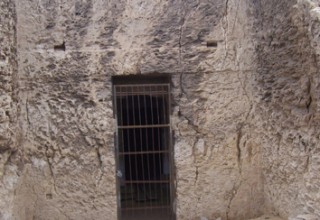Giza's Cave Underworld Sealed Shut
EGYPT'S CHIEF EGYPTOLOGIST CLOSES THE ENTRANCE TO THE CAVERNOUS REALM EXISTING BENEATH THE PYRAMIDS OF GIZA
Online, April 8, 2010 (Newswire.com) - Cairo: The entrance to Egypt's cave underworld has been sealed shut just two years after its modern day discovery. Access to the tomb leading to these natural caverns, located beneath the famous Pyramids of Giza, is now blocked by a metal gate set in concrete.
The move follows recent work to clear the interior of the tomb known as NC2 or the "Tomb of the Birds", and located in the plateau's north cliff.
This came in the wake of revelations in the press last summer that British explorer and writer Andrew Collins had in March 2008 located a previously unknown opening into a natural cave system long thought to exist at Giza, but never before explored in modern times.
The excavations inside the tomb - coordinated by Dr Zahi Hawass, Secretary General of Egypt's Supreme Council of Antiquities - uncovered a series of subterranean rooms and galleries thought to have been used in the past as a necropolis for the interment of bird mummies.
Despite these recent discoveries, Dr Hawass has publicly denied that any natural cave system extends from the tomb, stating that what exists beneath the ground are catacombs carved by human hands, something that Mr Collins disagrees with strongly.
"We have dozens of clear photos, along with film footage, that make it clear that extending from the Tomb of the Birds is an extensive series of cave passages that almost certainly reach beneath the main pyramid field," Collins said.
"These caverns are natural, and must not be confused with the subterranean galleries entered by Dr Hawass and his team, which are accessed elsewhere in the same tomb."
Collins backs up his claims by producing radar satellite imagery that shows geological faulting coinciding precisely with the position and orientation of the caves explored so far. This faulting is seen to extend hundreds of meters from the position of the tomb to beneath the plateau's Second Pyramid, the site of the fabled Cave-tomb of Hermes according to ancient Arab sources.
Collins's evidence is supported by the memoirs of British explorer Henry Salt who in 1817 records how he gained access to the same cave system, and explored them for a distance of "several hundred yards" before coming up four spacious chambers, from which went various labyrinthine passages.
With the sealing of the entrance to the tomb, any hope of further exploration in the caves now becomes impossible.
"It is sad that we won't be able to continue our investigations in the caves," Collins admitted. "Now only Dr Hawass's promised report on his clearance of the tomb can throw any further light on the caves, and their possible usage during an age even before the building of the pyramids some 4,500 years ago."
For more information on the rediscovery of Giza's cave underworld, see Andrew Collins's book Beneath the Pyramids (4th Dimension Press, Virginia Beach, VA, 2009).
